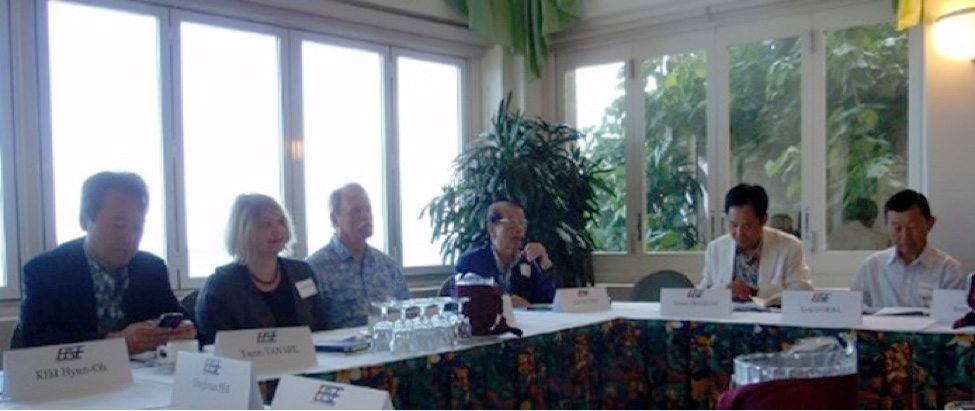NEAEF Held 14th Expert Working Group Meeting on Energy and Environment
You are here

Energy experts from Northeast Asia and the US gathered in Honolulu, Hawaii in April 2014 to discuss Clean Energy, the main topic of NEAEF’s 14th Expert Working Group Meeting on Energy and Environment. NEAEF and the College of Social Sciences of the University of Hawai’i at Manoa organized the meeting in cooperation with Hitachi, Hawaiian Electric Company, and the Hawaii Natural Energy Institute. Leading experts from Japan, Russia, South Korea, China, and the US were at hand to present and exchange views and country perspectives. Former Governor of Hawaii, George Ariyoshi, provided welcoming remarks.
Tanabe Yasuo, Executive Vice President of Government and External Relations for Hitachi called attention to the recent drop in nuclear energy use in Japan from 30% down to 2%, and the implications of this for Japan’s current and future energy mix for electricity generation.
Shi Dinghuan, Counselor of the State Council and China Renewable Energy Society Chairman, presented on the status of renewable energy in China and the outlook for cooperation with Northeast Asia. Professor Shi highlighted improvements in China’s energy structure use since 1990 with renewable energies reaching 9% in 2012.
South Korea, the world’s eighth largest consumer of energy resources, depends on imports to meet 96.4% of its energy demand. Therefore, great emphasis was put on the importance of Korea’s ‘energy cooperation diplomacy’ in an overview presented by Oh Sung-Hwan, Director of the Energy Security Division of the Ministry of Foreign Affairs of South Korea.
Russia’s strategy is to increase oil and gas exports up to 25% and 20% respectively in the Asia-Pacific region, according the Dimitry Reutov, Lead Manager, Department of Infrastructure and Oil and Gas Project of JSC Vladivostok. NEAEF is pleased to note that Mr. Reutov is a ‘graduate’ of the NEAEF Young Leaders Program (YLP), having participated in the 8th YLP meeting (Vladivostok 2103).
Terry Surles of the University of Hawai’i and Lead, Initiative for Sustainable Energy and Environment Solutions, pointed out that the US is using more renewable resources, and that its overall energy use has not risen in the past ten years. Due to the increase of renewable energy systems and increase in natural gas use (at the expense of coal), the US experienced 13% CO2 emissions reduction between 2007 and 2012. According to Dr. Surles, energy efficiency will “remain the best way to limit emissions and pursue economic growth.” Dr. Surles emphasized that “emergence of technologies associated with smart grid systems must occur to allow for a significant increase in the percentage of renewable energy systems on the grid.”
The working group meeting benefited from local expertise and information on energy in Hawaii. Ray Starling, Program Manager of Hawaii Energy at LEIDOS, provided an overview of the challenges associated with bringing fuel to Hawaii to support its energy needs. Given its geographical isolation and the fact that 80% of Hawaii’s electricity supply comes from oil, Hawaii is particularly vulnerable to fluctuations in oil prices and shipping costs.
James Griffin, Director of Planning and Research at Hawaii Public Utilities Commission emphasized further challenges Hawaii faces: removing barriers to grid integration, portfolio diversification, achieving optimal resource mix, and future energy demands. He pointed to a need for long-term planning and the use of Hawaii as a test bed for clean energy innovation.
Grid integration was also a salient topic in presentations by Richard Rocheleau, Director of the Hawaii Natural Energy Institute, and Scott Seu, Vice President of Energy Resources at Hawaii Electric Power Company. Dr. Rocheleau discussed challenges associated with integrating renewable energy sources due to small isolated grids. Mr. Seu described a new energy future that will see a transition from fossil fuels to clean energy, from a vertically integrated utility to an integrated grid, and the introduction of more flexible small generators.
Iinuma Yoshiki, Research Department Director of the Japan Electric Power Information Center (JEPIC) examined prospects for a regional cross-border power system as well as the Asian Supergrid and Gobitec initiatives for renewable energy in Northeast Asia. The Gobitec concept is to produce clean energy from renewable resources in the Gobi desert and import it to high-demand areas of Northeast Asia via an Asian Supergrid. According to Mr. Iinuma significant hurdles need to be overcome to implement these regional plans, among them are differing electricity supply systems (public and unbundled in China, private and vertically integrated in Japan, and public and private unbundled in Korea, Mongolia, and Russia) and security issues associated with North Korea.
Working group meeting participants also heard from Yimei Wong (Vice President of BYD Renewables, Americas) on BYD Company’s plans for future energy solutions, and from Uchida Mitsuho, former Director of the Central Research Institute of Electric Power Industry in Japan on the impact of climate change on the global economy.
Acting as session moderators for the meeting were former Governor of Alaska, Stephen Cowper and Denise Konan, College of Social Sciences Dean at the University of Hawai’i. Meeting attendees included former U.S. Senator for Hawaii Daniel Akaka, Kim Nam Ho, Manager or SK E&S Korea, and Kenji Sumida former President of the East-West Center. Representatives from the Consulates of Korea and Japan also attended. The meeting was chaired by NEAEF’s Chairman, Dr. Lee-Jay Cho.

